Theoretical Study of Some Angle Parameter Trigonometric Copulas
Abstract
1. Introduction
- for any;
- andfor any;
- the two-increasing property holds:for any.
2. Cosine Angle Parameter Copula
2.1. Definition and Graphics
- For any , we have , and, for any , .
- For any , we have and, similarly, for any , .
- For any , using standard derivation techniques, simplifications and factorizations, we have
- and ; or
- and which implies that , so this case is excluded; or
- and which implies that , so this case is excluded; or
- and , which implies that and , which is a polynomial of degree 2 with the discriminant equal to . Therefore, there is no (real) solution.
2.2. Related Functions
- Mixed copula 1: For any angle parameters and and , by setting , a possible mixed copula is given as
- Mixed copula 2: A second example is
2.3. Properties
- As already mentioned before:
- –
- For , it is clear that . Therefore, the cos-copula is reduced to the independence copula.
- –
- If we restrict our attention to the interval , the set is the optimal set of values for for validating as a copula.
- For any , we have . Hence, the cos-copula satisfies the negative quadrant dependence property (see [21]).
- The cos-copula is symmetric since for any .
- The cos-copula can be expressed under various analytical forms. Two of them are given below:
- –
- In terms of simple cosine-sine functions, we can writeWe thus see the intrinsic analytical complexity into the cos-copula.
- –
- In terms of power series, by using the cosine series expansion and binomial formula, we getIn particular, upon differentiation with respect to x and y on the interior of the domain of convergence, one hasThis expansion can be used in a variety of mathematical applications, such as determining various moment-type measurements.
- By arbitrary taking , we notice thatAs a result, the cos-copula is not Archimedean (see [1]). In other words, there is no generator function such that , where denotes the pseudo-inverse of .
- The cos-copula is not radially symmetric since there clearly exists such that .
- As any copula, the Fréchet–Hoeffding bounds can be expressed as follows: For any , we have .
- Thanks to the Kober inequality, the following inequality holds:where with refers to the Farlie–Gumbel–Morgenstern (FGM) copula (see [1]). Since , the cos-copula and FGM copula are involved in a complete copula ordering.
- For any , the two following results are obtained:andHence, the cos-copula has no tail dependence (see [1]).
- The medial correlation of the cos-copula is defined byIt is clearly a decreasing and negative function with respect to for , with for and for . Figure 5 represents the medial correlation for .Thus, the cos-copula has a weak medial correlation with .
- A useful dependence measure based on copula is the Spearman rho (see [1]). The Spearman rho of the cos-copula, as an example of copula, is defined by
- In complement of the Spearman rho, we can present the Kendall tau of the cos-copula. It is defined by
- The cos-copula opens some interesting perspectives in distribution theory and modeling. The most immediate of these perspectives is the creation of simple and new two-dimensional distributions with cumulative distribution functions of the following form: , sowhere and denote two cumulative distribution functions. This gives two-dimensional trigonometric distributions, which seem slightly underexplored in the literature. By considering the exponential distribution as the parent, we may define the cos-two-exponential distribution by the following cumulative distribution:and for . To understand the importance of the trigonometric distributions in theory and practice for the uni-dimensional case, we may refer to [22,23].
2.4. Data Generation and Inference
- Generate n data from a random vector , where S and T are independent random variables with the uniform distribution over .
- Choose a value of .
- Consider the following “conditional function”:
- For any , compute such that .
- Then are n data generated from the cos-copula defined with the chosen .
3. Sine Angle Parameter Copula
- Can we replace the angle-value with a tuning parameter and, if so, what is its “optimal values set”?
- What are the related functions of such a copula?
- What are its theoretical properties?
3.1. Definition and Graphics
- For any , we have , and, for any , .
- For any , we have , similarly, for any , .
- For any , using standard derivation techniques, we haveLet us now study the sign of the above function by distinguishing the case and the case .Case : We can writewhereandLet us prove that and .For , let us first remark thatTherefore, since and for any , we haveFor , since , we have , implying that , and . It follows that . HenceThe two-increasing property is proved.
3.2. Related Functions
- Mixed copula 1: For any angle parameters and , and , by setting , we can consider
- Mixed copula 2: Similarly, for any angle parameters and , and , by setting and , we can set
- Mixed copula 3: Another example is
3.3. Properties
- As already mentioned before:
- –
- For , it is clear that . Therefore, the sin-copula is reduced to the independence copula.
- –
- The set is the optimal set of values for for validating as a copula.
- For any , we have , so the negative quadrant dependence property is satisfied. Similarly, for any , we have , so the positive quadrant dependence property is satisfied (see [21]).
- The sin-copula is symmetric since for any .
- The sin-copula can be expressed under various analytical forms. Two of them are given below:
- –
- In terms of simple cosine-sine functions, we can writeAs a result, we can observe that the sin-copula has inherent analytical complexity.
- –
- In terms of power series, by using the cosine series expansion and binomial formula, we getIn particular, upon differentiation with respect to x and y on the interior of the domain of convergence, one hasThis expansion can be used to determine various moment-type measurements in a range of mathematical applications.
- By arbitrary taking , we notice thatAs a result, the sin-copula is not Archimedean (see [1]).
- The sin-copula is not radially symmetric since there exists such that .
- As any copula, the Fréchet-Hoeffding bounds can be expressed as follows: For any , we have .
- Thanks to the inequality: and the Jordan inequality: for (see [20]), we have a copula ordering between the sin-copula and FGM copula:
- –
- For , we have
- –
- For , the contrary holds:
- The following relationship between the cos-copula and sin-copula holds:Therefore, the following ordering results are established:
- For any , the two following results are obtained:andHence, the sin-copula has no tail dependence.
- The medial correlation of the sin-copula is defined byIt is clearly an increasing function with respect to for , with for and for . Figure 12 represents the medial correlation for .The possible values of this medial correlation are not negligible; we have . Hence, the sin-copula has a certain flexibility in this regard.
- The Spearman rho of the sin-copula, as an example of copula, is defined byUsing well-known mathematical methods, the following assertion provides a mathematical expression for this measure.
- For , we have and, by Equation (13), it is immediate that .
- For , still based on the definition of in Equation (13), we haveBy using a step-by-step integration, we obtainImmediately, the intended result occurs.
- For , thanks to the oddity of the sine function, we can writeSince , the expression of can be transposed with instead of , with the minus in factor of the overall expression.
- In complement of the Spearman rho, we can present the Kendall tau of the sin-copula. It is defined byThe complexity of the product function makes the closed form expression for unmanageable. We can, however, show that it is an increasing function with respect to for , with for , for and for . Figure 14 represents the Kendall tau for .The wide range of values of confirm the fact that the sin-copula is ideal to model moderate correlations.
- Similarly to the cos-copula, the sin-copula opens up several fascinating possibilities, such as the development of simple and new two-dimensional distributions with cumulative distribution functions of the form: , sowhere and denote two cumulative distribution functions. As a result, probabilistic or statistical modeling in this context becomes more feasible.
3.4. Data Generation and Inference
- Generate n data from a random vector , where S and T are independent random variables with the uniform distribution over .
- Choose a value for .
- Consider the following “conditional function”:
- For any , compute such that .
- Then are n data generated from the sin-copula defined with the chosen value of .
4. Conclusions and Perspectives
4.1. Conclusions
4.2. Perspectives
- Following the spirit of some power-extended FGM copulas (see [25]), one can think of considering some extensions of the cos-copula and sin-copula of the forms:andrespectively, where , and c are newly introduced shape parameters. However, the possible values of , and c such that and are valid copulas remain to discover.
- The n-dimensional versions of the cos-copula and sin-copula, which can be defined as and , respectively, whereandrespectively, deserve to be investigated for . Especially, the possible values for in this case need to be determined.
- Last but not least, other simple angle parameter copulas can be created on the basis of this study. One could think of defined bybut the optimal values of such that is a valid copula remain unknown. It is proven that satisfies the required conditions (in an unpublished work), but this set is thought to be less than optimal.
Funding
Acknowledgments
Conflicts of Interest
References
- Nelsen, R. An Introduction to Copulas, 2nd ed.; Springer Science+Business Media, Inc.: Singapore, 2006. [Google Scholar]
- Durante, F.; Sempi, C. Principles of Copula Theory; CRS Press: Boca Raton, FL, USA, 2016. [Google Scholar]
- Emura, T.; Chen, Y.-H. Analysis of Survival Data with Dependent Censoring, Copula-Based Approaches; JSS Research Series in Statistics; Springer: Singapore, 2018. [Google Scholar]
- Joe, H. Dependence Modeling with Copulas; CRS Press: Boca Raton, FL, USA, 2015. [Google Scholar]
- Alfonsi, A.; Brigo, D. New families of copulas based on periodic functions. Commun. Stat.-Theory Methods 2005, 34, 1437–1447. [Google Scholar] [CrossRef]
- Amblard, C.; Girard, S. Symmetry and dependence properties within a semiparametric family of bivariate copulas. J. Nonparametr. Stat. 2002, 14, 715–727. [Google Scholar] [CrossRef]
- Chesneau, C. A study of the power-cosine copula. Open J. Math. Anal. 2021, 5, 85–97. [Google Scholar] [CrossRef]
- Chesneau, C. On new types of multivariate trigonometric copulas. Appl. Math. 2021, 1, 3–17. [Google Scholar] [CrossRef]
- Chesneau, C. A note on a simple polynomial-sine copula. Asian J. Math. Appl. 2022, 2, 1–14. [Google Scholar]
- Durante, F. A new class of symmetric bivariate copulas. J. Nonparametr. Stat. 2006, 18, 499–510. [Google Scholar] [CrossRef]
- Jones, M.C.; Pewsey, A.; Kato, S. On a class of circulas: Copulas for circular distributions. Ann. Inst. Stat. Math. 2015, 67, 843–862. [Google Scholar] [CrossRef]
- Davy, M.; Doucet, A. Copulas: A new insight into positive time-frequency distributions. IEEE Signal Process. Lett. 2003, 10, 215–218. [Google Scholar] [CrossRef]
- Hodel, F.H.; Fieberg, J.R. Circular-linear copulae for animal movement data. bioRxiv 2021. [Google Scholar] [CrossRef]
- Knockaert, L. A class of positive isentropic time-frequency distributions. IEEE Signal Process. Lett. 2002, 9, 22–25. [Google Scholar] [CrossRef]
- Susam, S.O. A new family of archimedean copula via trigonometric generator function. Gazi Univ. J. Sci. 2020, 33, 795–802. [Google Scholar] [CrossRef]
- Xiao, Q.; Zhou, S.W. Modeling correlated wind speeds by trigonometric Archimedean copulas. In Proceedings of the 11th International Conference on Modelling, Identification and Control (ICMIC2019); Lecture Notes in Electrical Engineering; Wang, R., Chen, Z., Zhang, W., Zhu, Q., Eds.; Springer: Singapore, 2020; Volume 582. [Google Scholar]
- Hodel, F.H.; Fieberg, J.R. Cylcop: An R package for circular-linear copulae with angular symmetry. bioRxiv 2021. [Google Scholar] [CrossRef]
- Manstavičius, M.; Bagdonas, G. A class of bivariate independence copula transformations. Fuzzy Sets Syst. 2021, 428, 58–79. [Google Scholar] [CrossRef]
- Kober, H. Approximation by integral functions in the complex domain. Trans. Am. Math. Soc. 1944, 56, 7–31. [Google Scholar] [CrossRef][Green Version]
- Qi, F.; Hao, Q.-D. Refinements and sharpenings of Jordan’s and Kober’s inequality. Math. Inform. Q. 1998, 8, 116–120. [Google Scholar]
- Lehmann, E.L. Some concepts of dependence. Ann. Math. Stat. 1966, 37, 1137–1153. [Google Scholar] [CrossRef]
- Chesneau, C.; Artault, A. On a comparative study on some trigonometric classes of distributions by the analysis of practical data sets. J. Nonlinear Model. Anal. 2021, 3, 225–262. [Google Scholar]
- Tomy, L.; Satish, G. A review study on trigonometric transformations of statistical distributions. Biomet. Biostat. Int. J. 2021, 10, 130–136. [Google Scholar]
- Johnson, M.E. Multivariate Statistical Simulation; J. Wiley & Sons: New York, NY, USA, 1987. [Google Scholar]
- Bairamov, I.; Kotz, S. Dependence structure and symmetry of Huang-Kotz FGM distributions and their extensions. Metrika 2002, 56, 55–72. [Google Scholar] [CrossRef]


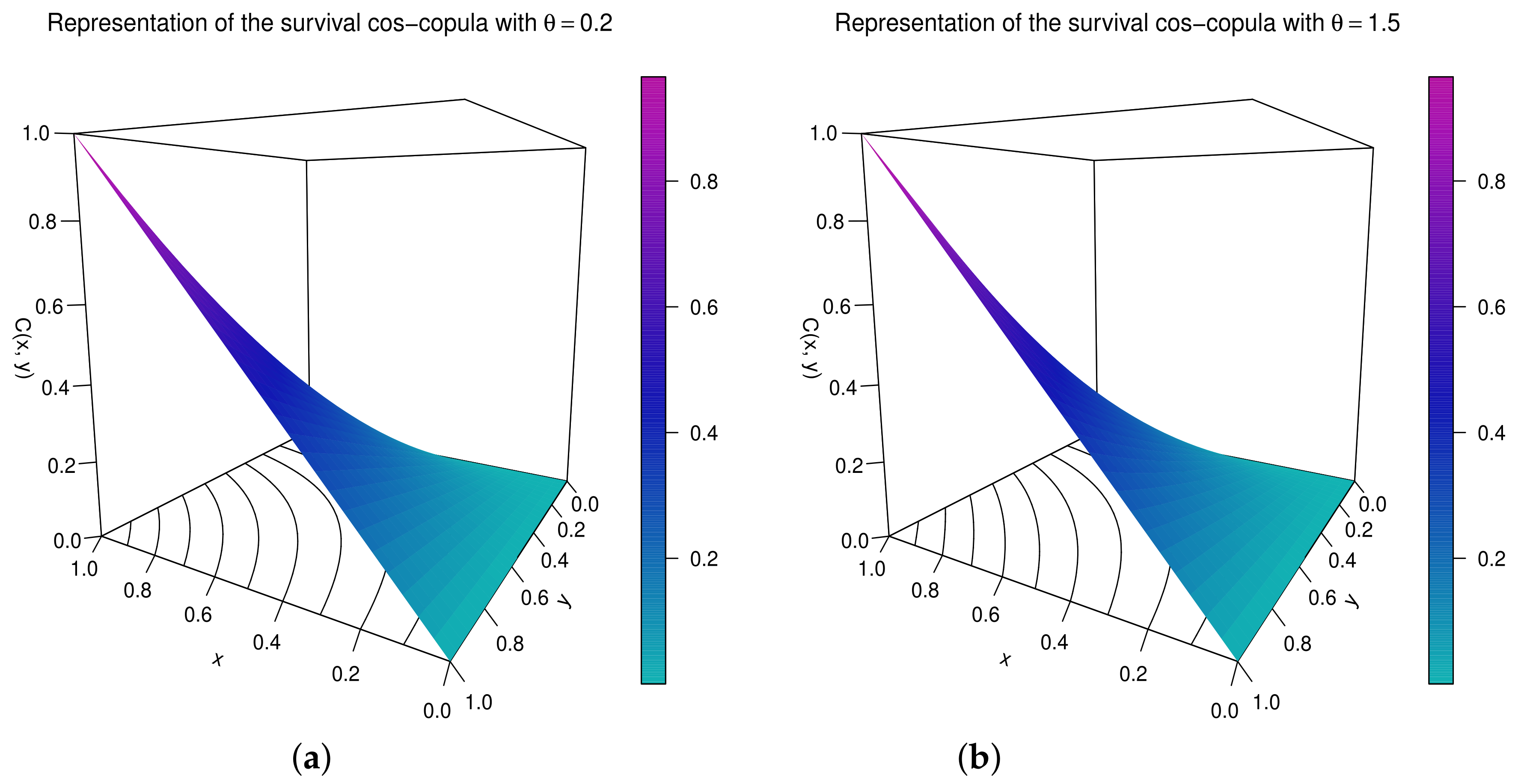


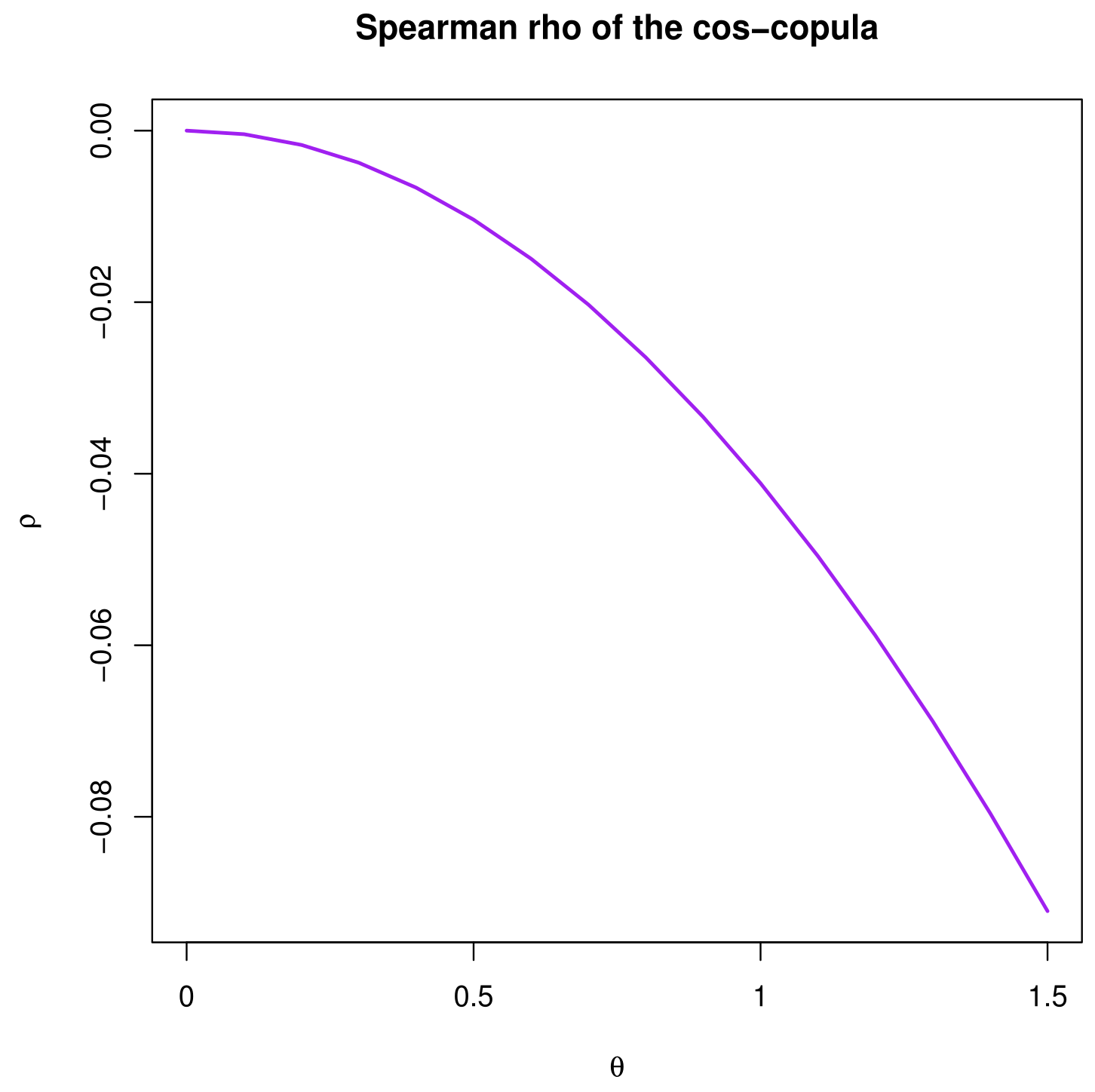
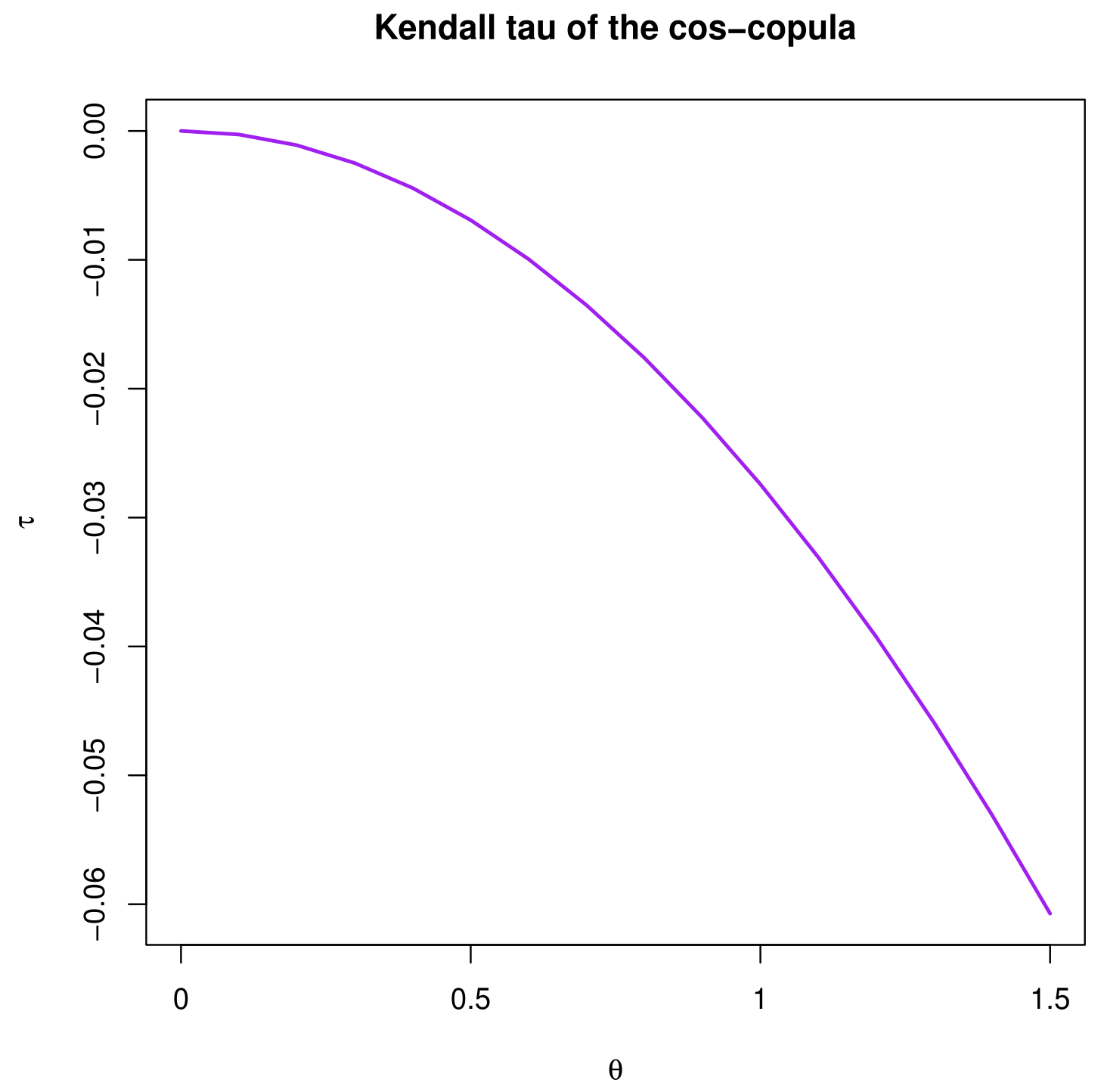
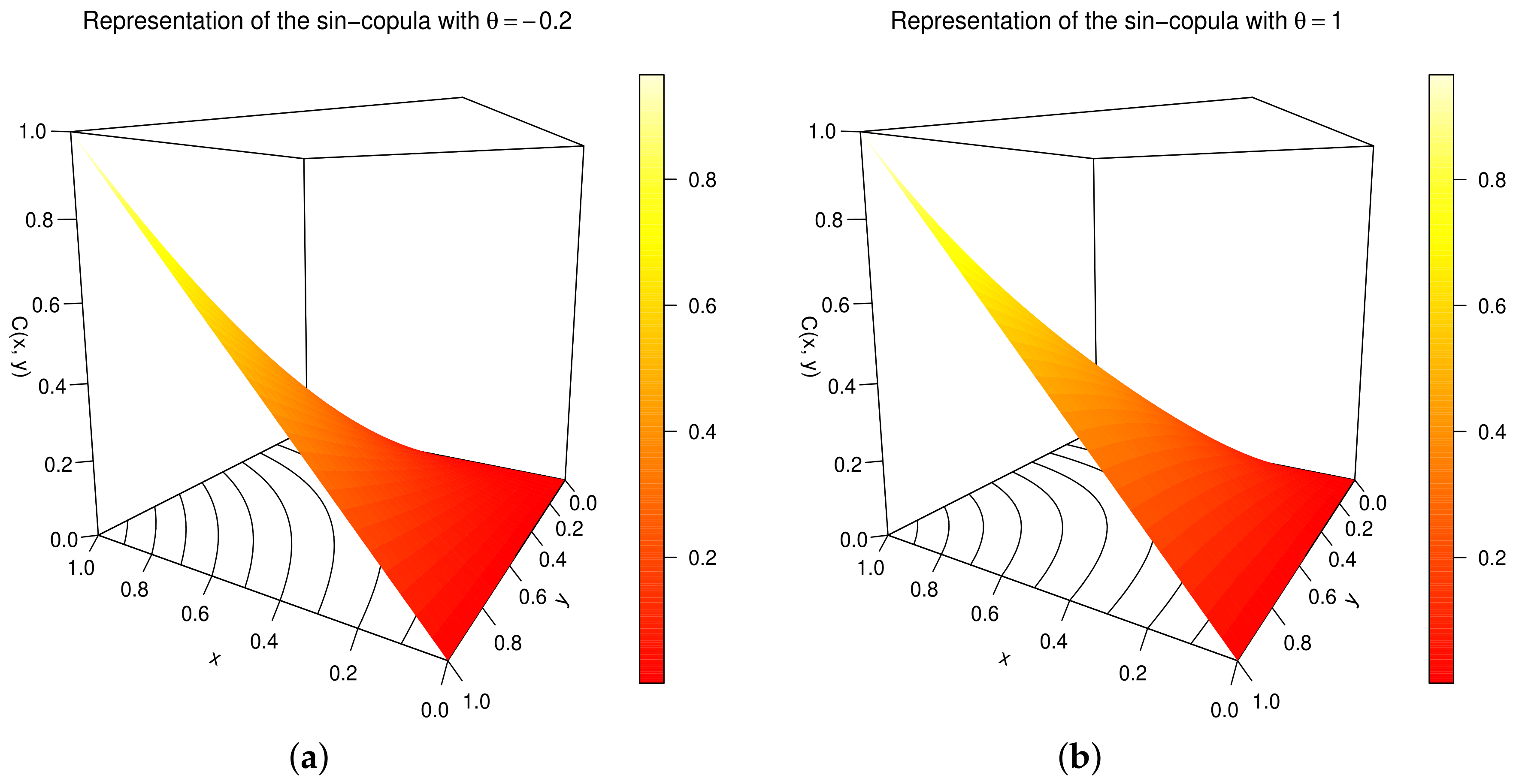




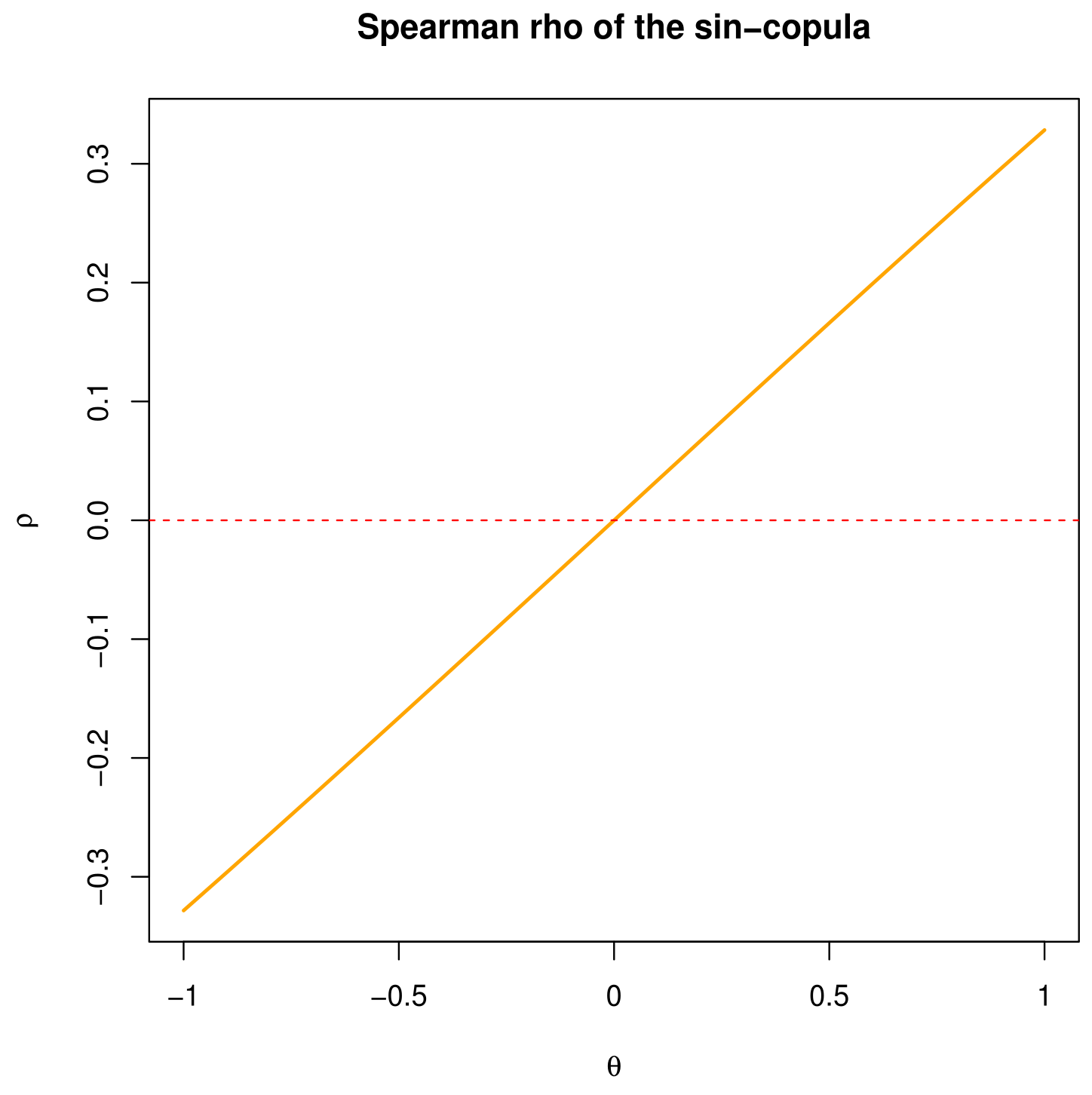
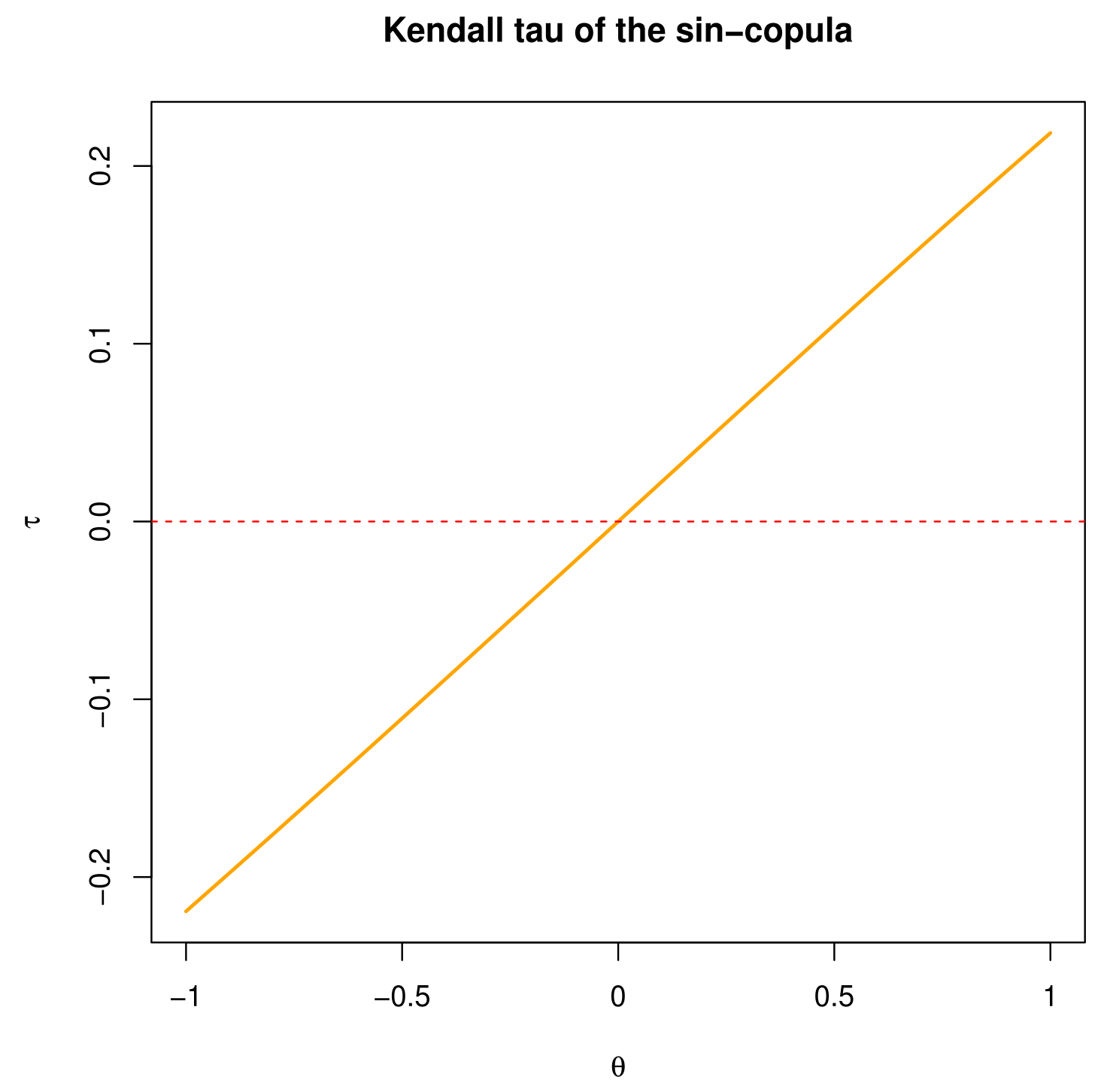
Publisher’s Note: MDPI stays neutral with regard to jurisdictional claims in published maps and institutional affiliations. |
© 2022 by the author. Licensee MDPI, Basel, Switzerland. This article is an open access article distributed under the terms and conditions of the Creative Commons Attribution (CC BY) license (https://creativecommons.org/licenses/by/4.0/).
Share and Cite
Chesneau, C. Theoretical Study of Some Angle Parameter Trigonometric Copulas. Modelling 2022, 3, 140-163. https://doi.org/10.3390/modelling3010010
Chesneau C. Theoretical Study of Some Angle Parameter Trigonometric Copulas. Modelling. 2022; 3(1):140-163. https://doi.org/10.3390/modelling3010010
Chicago/Turabian StyleChesneau, Christophe. 2022. "Theoretical Study of Some Angle Parameter Trigonometric Copulas" Modelling 3, no. 1: 140-163. https://doi.org/10.3390/modelling3010010
APA StyleChesneau, C. (2022). Theoretical Study of Some Angle Parameter Trigonometric Copulas. Modelling, 3(1), 140-163. https://doi.org/10.3390/modelling3010010




